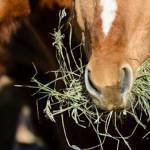Horse Hay Fiber Content Affects Intake

Forage represents an important part of any horse feeding program, and accordingly it is important to be able to accurately predict the amount of forage a horse will consume. In a presentation at a Kentucky Equine Research nutrition conference, equine scientists from the University of Kentucky reported on a literature review undertaken to determine if a relationship exists between chemical composition of forage and dry matter intake in mature horses.
The researchers reviewed six studies that looked at dry matter intake for 21 different forages. Four of the hay types were alfalfa-based (lucerne) and the other 17 were grass hays. Of the types of grass hay, some were made from cool-season varieties and others included both cool- and warm-season varieties.
The only chemical components consistently reported across all studies included crude protein (CP) and neutral detergent fiber (NDF). Based on these figures, the researchers examined the relationships of CP to dry matter intake and also NDF to dry matter intake. All of the studies used mature horses that were allowed free access to long-stem hay. Only studies that reported animal weights specific to each trial and measured intake over a minimum of four days were used.
The CP content of the grass hays ranged from 8.0 to 17.5%, while CP content of the legume hays was generally greater, ranging from 14.8 to 20.9%. The NDF content of the grass hays ranged from 59.5 to 74.9%, while the legume hays had somewhat less NDF, ranging from 40.9 to 56.3%.
NDF is made up of the structural parts of plants, and has low digestibility. In general, hays with higher NDF levels are not eaten as well by horses, and hays with NDF exceeding 65% will have low consumption by most horses.
All reported dry matter intake values were converted to figures relating daily intake to the horse’s body weight. Crude protein was not found to be strongly related to dry matter intake.
Intake per day for grass hays was higher for hays averaging 60% NDF than for hays averaging 75% NDF. The researchers did not perform analysis for intake of the alfalfa hays because of the small sample size, but analyses were made for intake for hays that were mixtures of grass and alfalfa. They found lower correlations between NDF and voluntary dry matter intake when both grass and legume hays were analyzed, possibly because of differences in the structure and digestibility of grasses and legumes. The data reviewed from these papers suggest that, when compared to CP, NDF values provide a better prediction of the dry matter intake of mature horses fed long-stem hay.
Horse owners choosing hay types and figuring how much hay to purchase should keep in mind that hays with a large percentage of rough, stemmy vegetation will have higher NDF content and will not be eaten as well by horses as hays made from finer, leafier forage. If only low-quality hay is available, horses should be provided with a larger amount so that they can pick through the hay and consume the more appealing and easily digested contents.








